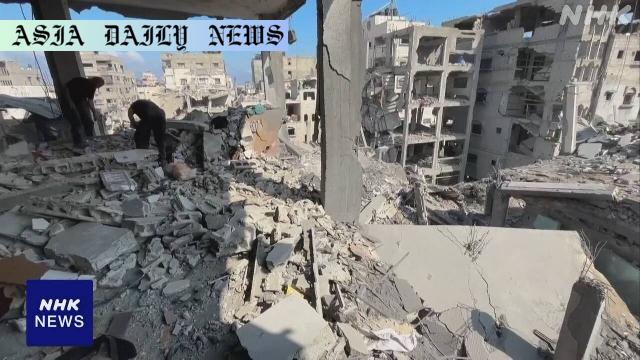Ceasefire: Hamas showcases willingness to negotiate a US-proposed 60-day truce plan, with conditions to ensure conflict resolution.
- Hamas expresses readiness to engage in US-backed ceasefire discussions.
- The 60-day truce proposal includes hostage exchanges and staged negotiations.
- Hamas seeks guarantees on a lasting peace and specific plan corrections.

Introduction to the Ceasefire Proposal
The ongoing conflict between Hamas and Israel in the Gaza Strip has taken a new turn, as Hamas has spoken positively about engaging in discussions over a United States-backed proposal for a 60-day ceasefire. The Islamic group has reportedly delivered its response to mediators, emphasizing a willingness to negotiate and implement the framework proposed by the US. However, Hamas has indicated the need for certain corrections to the plan to address its concerns effectively.
The Details of the US-Proposed Plan
The centerpiece of the plan involves a 60-day cessation of hostilities, during which multiple peace efforts and exchanges are expected to unfold. A key condition includes the release of 10 living hostages by Hamas and the return of 18 bodies to Israel in stages throughout the ceasefire period. This exchange is intended to build mutual trust as the two sides work towards broader conflict resolution. However, according to local media sources, Hamas is requesting additional guarantees, ensuring that this temporary arrangement paves the way for permanent peace and does not merely serve as a short-term solution.
Past Efforts and Challenges for Lasting Peace
Previous ceasefires between the two factions have faced significant challenges. In January, a temporary truce held briefly but fell apart by March due to a lack of progress in negotiations. This history of stalled talks raises critical questions about the viability of the current proposal. Hamas has explicitly sought assurances that this agreement will yield substantive steps toward de-escalation and comprehensive peace.
The Toll of Continued Hostilities
The human cost of the protracted conflict is staggering. Health officials in Gaza report that the death toll since the outbreak of hostilities in October 2023 stands at a devastating 57,268 lives lost. The urgency for a ceasefire has never been more apparent, as civilians bear a disproportionate burden of the consequences of war. Both sides face mounting pressure from the international community to pursue avenues for peace.
The Role of Mediators and Global Leadership
Mediators have played a pivotal role in advancing this 60-day truce proposal. The involvement of the United States, under the leadership of President Donald Trump, signals a significant international effort to de-escalate the conflict. The US has exerted pressure on both sides to come to the negotiating table, with Israel reportedly accepting the conditions outlined in the plan. However, addressing Hamas’s concerns and ensuring equitable treatment in the negotiations will be critical to achieving a lasting resolution.
Conclusion and Future Prospects
If the proposed ceasefire goes into effect, it could represent a critical step toward reducing violence and fostering dialogue. However, the complexity of the issues at hand, coupled with the history of mistrust and unmet commitments, underscores the challenges of achieving lasting peace. The international community’s role in maintaining pressure and supporting transparent negotiations will be indispensable in this process.



Commentary
The Importance of a Ceasefire in the Gaza Conflict
The potential for a ceasefire in the Gaza Strip marks a pivotal moment in the long-standing conflict between Hamas and Israel. The willingness expressed by Hamas to engage in discussions is undoubtedly a positive step, but it also highlights the complexities involved in achieving lasting peace in such a volatile region. Temporary agreements, while providing immediate relief, often fail if not accompanied by long-term reconciliation efforts.
The Challenges of Mutual Trust
One of the significant challenges in implementing the ceasefire is the lack of trust between the two parties. Both Hamas and Israel have experienced unmet promises and failed negotiations in the past, which contributes to skepticism about the viability of new agreements. For example, while Israel has reportedly agreed to the conditions of the truce, Hamas has introduced additional demands, such as guarantees for a permanent resolution. These conditions reflect the deep-rooted mistrust and highlight the need for stringent oversight during negotiations.
A Humanitarian Perspective
The humanitarian toll of this conflict cannot be overstated. With death tolls rising into the tens of thousands, the human suffering is unfathomable. Civilians, especially women and children, often bear the brunt of the violence. A 60-day ceasefire could provide a crucial window of respite for those affected, offering an opportunity for aid organizations to deliver much-needed assistance to the region.
Global Implications and the Role of Leadership
The international community plays a significant role in this scenario. The involvement of the United States, spearheaded by high-profile leaders, emphasizes the global importance of resolving this conflict. However, it is essential for global actors to recognize and address the nuances of this situation. Lasting peace will require not just political agreements but also efforts to bridge the social and cultural divides that have fueled decades of unrest.
Looking to the Future
The road to peace is long and fraught with challenges, but the mere possibility of dialogue offers a glimmer of hope. The international community, mediators, and the conflicting parties must remain steadfast in their commitment to achieving a resolution. Only through sustained efforts, trust-building, and equitable solutions can there be hope for a peaceful future in the Gaza Strip and beyond.